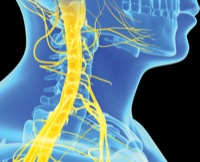Positive Pilot Study of Noninvasive Vagus Nerve Stimulation for Acute Treatment of Migraine

An open-label, multicenter, pilot study suggests that noninvasive vagus nerve stimulation (nVNS) can be effective for acute treatment of migraine.
An analysis of 25 women and two men treated with nVNS for migraine with or without aura showed that patients were pain-free two hours after treatment in 38% of mild migraine attacks and 22% of moderate or severe attacks. Twelve of the patients had adverse events, but all were mild or moderate, according to a presentation of the results by Peter Goadsby, MD, PhD, at the American Academy of Neurology’s 2013 annual meeting, held recently in San Diego.
“Noninvasive or transcutaneous VNS is well tolerated and seems to be effective in acute migraine,” concluded Dr. Goadsby, professor of neurology at the University of California, San Francisco. “This points to the importance of getting on with controlled trials—and indeed there are two studies each in Europe and the U.S. under way already.”
Ana Recober, MD, assistant professor of neurology at the University of Iowa, University Heights, chaired the session at which Dr. Goadsby presented the data. She praised the results as being “exciting” and warranting “follow-up with a larger randomized, double-blinded, sham-controlled clinical trial.”
“The headache community is looking for new, innovative acute-migraine treatments, and non-medicinal therapies with minimal side effects are very attractive,” said Todd Rozen, MD, director, Geisinger Headache Center, Geisinger Health System, Wilkes-Barre, Pa. “The two-hour data for pain freedom and pain relief in the study are promising, but the investigators didn’t indicate whether the pain returns within 24 hours, or even within four hours for that matter. Also, no data were presented on what happened to migrainous-associated symptoms—such as nausea and vomiting—with treatment.”
He agreed that results from the controlled trials would be useful. Dr. Goadsby said data on migraine symptoms up to 24 hours post-treatment would be included in a paper that is being prepared for submission to a medical journal.
The pilot study was paid for by ElectroCore, which makes the gammaCore device that was used in the study. The goal was to build on several published case series on use of nVNS that showed it relieved some patients’ migraine symptoms (see, e.g., Cephalalgia 2005;25:82-86).
The participants had a median age of 39 years. Each was treated with nVNS for four consecutive migraine attacks, either with immediate treatment for moderate or severe attacks, or after 20 minutes of mild pain. Each treatment consisted of one 90-second dose followed by another dose 15 minutes later.
The initial study population included 30 individuals but three did not have any attacks treated; thus, the intent-to-treat group comprised 27 subjects. In that group, there were 84 attacks, 55 of which were moderate or severe. In 10 of the mild attacks (38%) and in 12 of the moderate or severe attacks (22%), the patients were pain-free after two hours.
Three patients experienced neck twitching at the location of the treatment; one had neck redness; and another reported a raspy voice. The adverse effects all were only present during the stimulation time and resolved spontaneously.
—Rosemary Frei, MSc
Dr. Goadsby is a consultant with ElectroCore. Drs. Recober and Rozen did not disclose any relevant conflicts of interest.
http://www.painmedicinenews.com/ViewArticle.aspx?d=Nonpharmacologic%2BTherapy&d_id=84&i=June+2013&i_id=963&a_id=23359

No comments:
Post a Comment